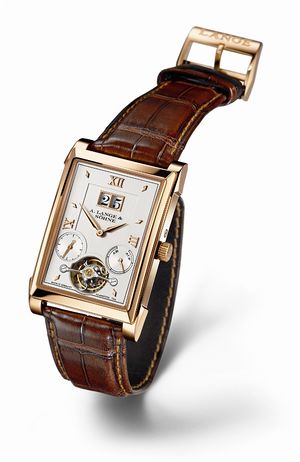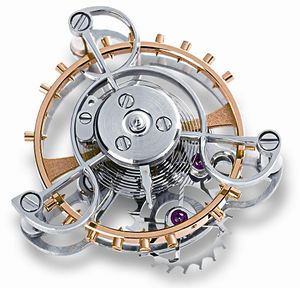Progress through Standstill: the CABARET TOURBILLON
Progress through Standstill: the CABARET TOURBILLON
The tourbillon was invented of Abraham-Louis Breguet more than 200 years ago. It has lost none of its fascination since then. A. Lange & Söhne has just written a new chapter in the history of the “whirlwind” with the new CABARET TOURBILLON and the first stop-seconds feature ever implemented in a tourbillon calibre.
In 1997, the CABARET amazed the world with its elegant rectangular shape that evoked the luxury, charisma, and perfection of the Art Deco epoch. Eleven years after the launch of its predecessor, the CABARET TOURBILLON by A. Lange & Söhne now sets the stage for a world debut starring the balance in a rotating carriage. For the first time ever, the “whirlwind” – the literal translation of tourbillon – has been tamed with a stop-seconds mechanism.
But first things first. An ingenious idea inspired the development of the carriage escapement for which a patent was filed in 1801. It was predestined for pocket watches that were typically slipped into a vest pocket in the same upright orientation. In the tourbillon, the rate-governing parts – the balance and escapement assemblies – were integrated in a cage that rotated about the fourth wheel. This neutralised the position error caused by the pull of gravity on the balance wheel which can never be poised with absolute perfection, resulting in greater rate accuracy. In modern wristwatches that are worn in constantly changing orientations, the need for rate corrections is no longer a significant issue. Nonetheless, because of its intricacy and complexity, the tourbillon has lost none of its original fascination. Executed in artisanal perfection as in the three tourbillon calibres crafted so far at Lange, it remains the archetype of horological complications mastered only by the best of the watchmaking elite.
Yet one question remained unanswered: if the tourbillon stands for superior rate accuracy, why had no one so far invented a device that would make it possible to instantaneously and precisely stop and restart such a watch for synchronisation purposes? This awkward enigma that persisted throughout the 200-year history of the tourbillon challenged the calibre designers at Lange who finally found a solution. They decided against the option of stopping the entire tourbillon cage mechanically from within the movement. With this rather simple approach, the balance wheel would slow down and eventually coast to a halt. It would need to be “kick-started” to resume its reciprocating motion. This unsatisfactory approach was rejected. To preserve the potential energy of the balance spring during the braking process, the only viable alternative was to directly and instantaneously brake the balance wheel inside the cage itself. This was the only way to assure that the balance wheel would immediately begin to oscillate again after the “brake” had been released.


